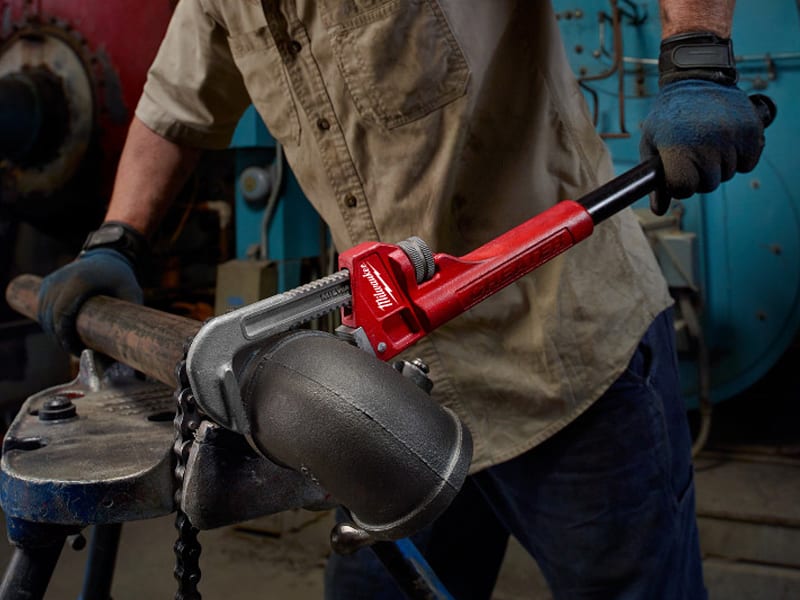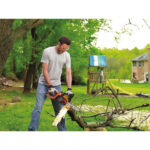Pipe Wrenches
Pipe wrenches are an essential tool used by plumbers, mechanics, and DIYers for gripping and turning rounded workpieces such as pipes and fittings. The history of the pipe wrench dates back to the late 1800s.
In 1869, an African American inventor named S.T. Taylor patented an early version of the modern pipe wrench, though his design was fairly primitive. The iconic, adjustable style pipe wrench that we know today was invented in 1885 by Daniel C. Stillson, who worked as a mechanical engineer. Stillson came up with the idea when he was trying to find a better way to turn water pipes during plumbing work. His wrench design, patented under the name “Stillson Wrench”, allowed the jaws to be adjusted for different pipe sizes.
The basic mechanics of a pipe wrench have remained largely unchanged since Stillson’s time. Pipe wrenches grip the pipe with serrated or grooved jaws that are situated on an adjustable pivot. When the handle is turned, the movable jaw applies pressure against the pipe’s surface through leverage action. This allows the wrench to get a firm grip and generate high amounts of torque. Most pipe wrenches have teeth that face inward when pressure is applied, causing them to tighten onto the pipe when turned in a clockwise direction.
Today, pipe wrenches continue to be a go-to tool for plumbers, steamfitters, mechanics, and others working with cylindrical objects. They are commonly used during plumbing tasks like installing, removing, or repairing water and gas pipes. Pipe wrenches are also handy for mechanics working on parts with hex shapes like nuts, rods, and fittings. The ability to adjust the jaws makes them versatile for various pipe and bolt sizes. Proper use of a pipe wrench requires a good understanding of how to avoid stripping or breaking pipes.
Table of Contents
Key Components
Pipe wrenches have a few key components that allow them to grip and turn pipe and fittings.
Adjustable Jaw
The adjustable jaw is one of the main parts of a pipe wrench. It is located on one side of the wrench head and can be moved closer to or farther from the fixed jaw to grip different sized pipes. The adjustable jaw has grooved or serrated teeth that dig into the pipe to get a solid grip when turning.
Fixed Jaw
Opposite the adjustable jaw is the fixed jaw, which is stationary and does not move. Like the adjustable jaw, it also has grooved or serrated teeth to firmly grip the pipe. The fixed and adjustable jaws work in tandem to hold the pipe in place.
Thumb Screw
The thumb screw is used to control the adjustable jaw and determine how wide the gap between the jaws is. Turning the thumb screw clockwise moves the adjustable jaw closer to the fixed jaw, while turning it counterclockwise opens up the gap between the jaws. The thumb screw needs to be tightened sufficiently when gripping a pipe to prevent slippage.
Handle
Pipe wrenches have a long handle that provides the leverage needed to turn and tighten or loosen pipes. The handle allows the user to generate substantial torque. Most pipe wrench handles have a cushioned grip for comfort during use. The handle length varies based on the overall size of the wrench.
Common Types
There are several common types of pipe wrenches that are designed for different purposes:
Straight Jaw
The traditional straight jaw pipe wrench has fixed jaws and is designed for turning round objects. The jaw design gives maximum grip and torque for pipes and fittings. Straight jaw wrenches work well for plumbing applications.
Chain
Chain pipe wrenches have an adjustable chain jaw that conforms to a variety of shapes and sizes. The chain design allows the wrench to grip and turn odd-shaped objects that a straight jaw cannot. Chain wrenches are often used for mechanical applications.
Plastic
Plastic pipe wrenches have jaws made of durable reinforced polymers instead of metal. The plastic material makes the wrench lightweight while still providing grip strength. Plastic wrenches are useful in applications where metal tools could damage soft materials like PVC pipe.
Aluminum
Aluminum pipe wrenches are lighter weight than traditional steel models. The aluminum material reduces hand fatigue for extended use while still providing strength and durability. Aluminum wrenches are a good choice for tight spaces where a steel wrench is too bulky.
Size Considerations
When selecting a pipe wrench, it is important to consider the size of the pipes you’ll be working with as well as your own strength and stamina. Pipe wrenches come in a wide range of sizes to accommodate different pipe diameters.
Diameter Capacity
- Pipe wrenches are available to grip pipe from 1/8″ to several inches in diameter. Measure the outside diameter of your pipe to determine the capacity you need.
- Standard pipe wrench sizes include 4″, 6″, 8″, 10″, 14″, 18″, 24″, and 36″.
- Mini pipe wrenches for small pipes are available in sizes like 6″ and 10″.
- Larger pipe wrenches over 24″ are made for heavy duty applications.
Available Lengths
- Pipe wrench length indicates the maximum reach when open.
- Common lengths are 6″, 10″, 18″, 24″, 36″, and 48″.
- Longer wrenches provide more gripping leverage on pipes.
- Compact, shorter lengths are easier to handle in tight spaces.
Weight
- Pipe wrench weight increases with size.
- Smaller 6″ and 10″ wrenches weigh around 1-2 lbs.
- Medium sizes like 14″ and 18″ weigh approximately 4-8 lbs.
- Larger 24″ and 36″ models weigh around 10-18 lbs.
- Consider your ability to safely lift and operate the wrench for extended periods.
Materials
Pipe wrenches are typically made from durable metals that can withstand high amounts of torque. The most common materials used are:
Steel
Steel is the most common material used to construct pipe wrenches. Steel provides high strength and durability to withstand the forces involved in turning pipes and fittings. Most major pipe wrench brands use steel for the handle, jaws, and adjusting mechanisms. Steel allows for a lighter weight tool compared to other metals while still providing strength.
Cast Iron
Some pipe wrenches may use cast iron for certain components, like the jaw and nut. Cast iron provides added strength and rigidity but increases the tool’s overall weight. While heavier, cast iron jaws can grip better without deforming as much under high pressure.
Aluminum
Aluminum is sometimes used for handles and adjustment mechanisms to reduce weight. Aluminum has good strength-to-weight characteristics but may not be as durable as steel for high torque tasks. Pipe wrenches made mostly of aluminum are more suitable for light duty applications.
Plastic
Some pipe wrenches may incorporate plastic components, usually for the gripping handle. While plastic is lightweight, it lacks the strength and hardness of metal. Plastic components are found on lower quality pipe wrenches not intended for heavy industrial use.
Proper Use
Using a pipe wrench correctly is important for both safety and effectiveness. Choose the right size wrench for the job – too large and you won’t be able to grip properly, too small and you risk rounding off plumbing fittings.
When using an adjustable pipe wrench, open the jaws until they fit over the pipe. Position the wrench so the jaws form a 15-20 degree angle toward the direction you intend to turn the pipe. Tighten the adjustable jaw so it grips the pipe firmly but not so tight that it risks crushing the pipe.
Grip the wrench handle firmly with both hands. Place one hand as close to the jaws as comfortable, and use your palm to apply pressure against the heel of the wrench handle. This gives you increased leverage. With your other hand, grip the handle further down to control and turn the wrench.
Apply smooth, steady pressure when turning the wrench rather than jerky movements. Take care not to over-torque fittings made of soft metals like copper or plastic. If properly gripped, just 10-15 ft-lbs of torque should be sufficient for small diameter pipes. Larger pipes may require more torque, but take care not to exceed the pipe or fitting manufacturer specs.
Safety Tips
When using a pipe wrench, following some basic safety tips can help prevent injuries and damage.
- Wear thick work gloves and eye protection. Pipe wrenches can pinch fingers and hands. Gloves help protect against pinches and scrapes from sharp threads and burrs. Safety goggles guard against eye injuries if anything breaks or flies off while applying torque.
- Avoid over-torquing. It’s easy to apply too much force with a pipe wrench. This can damage pipes, break fasteners, or cause the wrench to slip suddenly and violently. Use the minimum force needed to tighten or loosen.
- Ensure good footing. Pipe wrenches can easily slip if you don’t have a solid stance. Stand with your feet shoulder-width apart for stability. Avoid using pipe wrenches in awkward positions that put you off balance. Having both hands on the tool also helps control it.
- Check for obstructions. Make sure the area around the pipe is clear before swinging the wrench. Walls, equipment, or other pipes can get in the way of the arc of the handle and cause accidents.
- Consider using a pipe wrench extension for added leverage and injury prevention in tight spaces. Extensions provide extra reach without having to overexert force.
Following basic safety precautions helps minimize the potential hazards of using pipe wrenches. Taking steps to protect yourself and being mindful of proper wrench handling techniques can help prevent painful mishaps.
Maintenance
Proper maintenance is crucial to keeping your pipe wrench in good working order. Here are some tips:
Keeping Clean
- Wipe down the tool after each use to remove any dirt, grime, or residue that may have built up. Use a clean rag or paper towel with a bit of solvent if needed.
- Periodically disassemble the wrench and clean all surfaces. Remove any rust or corrosion.
- Avoid allowing dirt or debris to build up in crevices or joints. This can cause the mechanism to jam.
Lubrication
- Apply a light oil or lubricant to the adjusting nut and worm gear periodically. This prevents rust and keeps the parts moving smoothly.
- Wipe away excess lubricant and do not allow oil to get on the jaws – this can cause slippage.
Inspecting for Damage
- Check for any cracked, bent, or worn parts. The jaws should close flush without gaps.
- The knurled adjusting nut should turn smoothly without wobbling.
- Look for loose or damaged screws that may need tightening or replacing.
Replacing Parts
- Many pipe wrench parts like jaws, pawls, gears and pins can be individually replaced if damaged. Consult the manufacturer.
- Use only manufacturer-approved replacement parts to ensure proper fit and operation.
- Be careful not to overtighten screws or bolts when reassembling.
Regular cleaning, lubrication, inspection and part replacement when needed will keep your pipe wrench in optimal working condition for years of use. Proper maintenance is well worth the small time investment.
Brand Comparison
When it comes to pipe wrenches, there are a few major brands to consider:
Ridgid
Ridgid is known for making heavy-duty, professional-grade tools. Their pipe wrenches are no exception. Ridgid pipe wrenches feature cast iron construction and hardened steel jaws. They come in a wide range of sizes from 8″ to 60″. Ridgid wrenches have a reputation for being extremely durable and long-lasting, though they do come at a higher price point than other brands.
Craftsman
Craftsman has been making tools for decades and is known for dependable quality. Their pipe wrenches have chrome plating to prevent rust and come in common sizes from 10″ to 18″. Craftsman tends to be a good budget-friendly option. While not as heavy-duty as Ridgid, Craftsman wrenches offer reliable performance for most homeowners and DIYers.
Irwin
Irwin Tools produces a range of Vise-Grip locking wrenches that can be used similarly to traditional pipe wrenches. Their Vise-Grip plumbing wrenches feature grooved lower jaws and flat upper jaws to grip pipes securely. They come in sizes from 6″ to 12″ and their compact size makes them easy to use in tight spaces. While not as powerful as full size pipe wrenches, Irwin’s Vise-Grips offer versatility and convenience.
When choosing a pipe wrench, consider how often you’ll use it and for what types of jobs. Ridgid is the best choice for frequent heavy-duty use. Craftsman offers reliable quality at a more affordable price point for occasional jobs. Irwin’s Vise-Grips provide versatility for tight spaces. Choose the option that best fits your needs and budget.
Conclusion
Pipe wrenches are an essential tool for plumbers, mechanics, and DIYers. To recap, pipe wrenches come in many types and sizes to fit different pipe diameters and materials. The key components of a pipe wrench include the adjustable jaw, heel jaw, and handle. When using a pipe wrench, it’s important to properly position it at a 15-20 degree angle from the pipe to maximize grip and avoid rounding off pipe edges. Safety should always be a top concern, so wear gloves, watch your knuckles, and avoid overexerting yourself.
While pipe wrenches may seem straightforward, there are some nuances to selecting the right model and using it properly. With the information provided in this guide, you should now have a better understanding of pipe wrench options, sizing, materials, usage tips, and maintenance. Equipped with this knowledge, you can choose the right pipe wrench for your needs and use it effectively for plumbing, auto work, and home repairs.
For more information on pipe wrenches, consult these additional resources:
- Manufacturer websites like Ridgid and Crescent for product specs, manuals, and videos
- DIY sites like Family Handyman for step-by-step wrench usage tips
- YouTube tutorials demonstrating proper pipe wrench techniques
We’ve covered the key things you need to know about pipe wrenches. With the right pipe wrench and skills, you’ll be prepared to take on any threaded pipe task.



